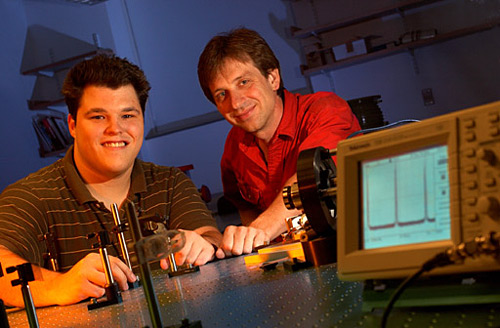Physics major Timothy Bragdon ’04 (Rahway, N.J.) is using the Doppler Effect to investigate the fundamentals of atomic collisions this summer in an EXCEL Scholars project with Andrew Kortyna, assistant professor of physics.
Titled “Doppler-Free Saturated Absorption Spectroscopy of Alkali Atoms,” the project’s importance lies in stabilizing the wavelengths of lasers, says Kortyna.
The Doppler Effect is a phenomenon used in astronomical measurements, radar, and modem navigation, among other uses. To understand it, think of the sound of an ambulance siren as the vehicle approaches or moves away from you, Bragdon explains. The sound appears to change pitch, which is what happens to an atom. When atoms are moving toward a light source, the light appears blue-shifted. Those atoms will absorb at a lower-than-expected frequency. This shifting is referred to as the Doppler Effect.
“Timothy’s project is a small piece of a larger project on low-energy atomic collision physics,” says Kortyna. “The goal of our project is to study atomic collisions at temperatures between two temperature regimes, a region where theorists are having a difficult time making accurate predictions.”
“Right now I’m busy constructing an integrated feedback circuit to lock the wavelength of light to a specific frequency,” says Bragdon. “This circuit, once locked, should keep the length of the laser cavity and, in effect, the wavelength of the standing wave static. If the wavelength starts to drift, the circuit should correct the drift.”
“All equipment must be custom built at Lafayette, and we must create experimental procedures as we progress,” says Kortyna. “Timothy is doing a project heretofore undertaken only by seasoned researchers. While I am confident in Timothy’s ability to succeed, he is following a path taken, so far, by few.”
“This project allows me to gain a new understanding of modern circuitry and its applications,” says Bragdon. “Also, I knew little about Doppler-free saturated absorption spectroscopy, and this project is allowing me to discover different connections from classes I have already taken and hopefully will provide new connections further down my path in academia. EXCEL projects give students the ability to go beyond the textbook and experience a snapshot of the pursuit of actual discovery.
“This project goes well beyond what I have done until now in physics, but because of the previous courses I have taken, it becomes easier every day. The main thing that excited me about this project was new knowledge. I have the ability to learn and produce simultaneously. That’s really exciting!”
Through his work, Bragdon is learning how to engineer working scientific instrumentation and use it in research. Kortyna says that the opportunity to get involved in the design and construction of instrumentation is strongly dependent on the active experimental physics program at Lafayette.
“I am very glad to be working with Andy, but I would be glad to work with any of the physics professors,” says Bragdon. “They are all extremely helpful and encouraging. This willingness to educate and share is very encouraging.”
Treasurer of Physics Club, Bragdon was a member of this year’s Lafayette Math Bowl team and placed third in the Lehigh Valley Association of Independent Colleges Math Barge Competition and the Lafayette Math Barge Competition, both held in fall 2001. He was on the student panel for a brown bag discussion on Lafayette’s Course Information site, serves as a resident advisor, and is a member of the College Democrats. He also is vice president of Phi Kappa Psi fraternity.

Timothy Bragdon ’04 researched atomic collisions as an EXCEL Scholar with Andrew Kortyna, assistant professor of physics.
